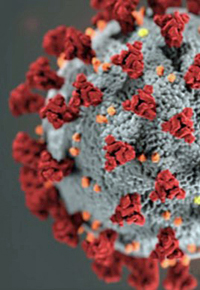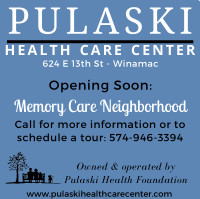
Indiana Gov. Eric Holcomb (who is now quarantining himself due to exposure to members of his security crew who have tested positive) has recommended that Hoosier families limit Thanksgiving gatherings, even suggesting including only household members.
Pulaski County began the month of October with 114 cases of COVID-19 and one death since the pandemic began. By Nov. 18 those numbers rose to 343 cases and 10 deaths. The counties that surround Pulaski County have reported higher surges in case numbers and deaths. On Wednesday (Nov. 18) neighboring counties reported new daily cases as follows: Jasper 21, Starke 21, Marshall 59, Fulton 29, Cass 26, and White 25.
The state's seven-day positivity rate (for unique individuals) has risen from 9.3 percent on Oct. 10 to 23.6 percent on Nov. 18.
“No longer concentrated solely in urban areas or in nursing homes, prisons and factories, the virus seems to flourish wherever people let down their guard,” the Washington Post has pointed out in its daily summary on the pandemic.
The Indiana State Department of Health reports (on Nov. 18) 21 counties in its "red" range of 200 or more cases per 100,000 resdients (up from nine the previous week). Pulaski County has moved into orange range of 100 to 199 cases per 100,000 residents. Pulaksi County also has a 14.3% seven-day positivity rate (for all tests) - markedly higher than surrounding counties, except for White.
State and local health officials agree that more and more, young adults in their 20s and 30s, usually asymptomatic, are spreading the virus unknowingly among each other and heartbreakingly to older members of the community who are most vulnerable to being hospitalized for, or dying from the virus. That said, the governor also acknowledges COVID is being spread by every age group to every age group.
With the case numbers growing in Pulaski County, the pressure is rising to inform the public how and where the virus is spreading, while continuing to adhere to privacy laws.
Pulaski County Health Department director Terri Hansen reports local health officials are explaining COVID-19 is now infecting largely through “community spread” - and particularly asymptomatic spread - through any large or small gathering with contact closer than six feet for more than 15 minutes that includes an infected person.
"It is vital that we all follow social distancing and mask-wearing recommendations," the health department urges. "Additionally, we highly recommend that large gatherings be reconsidered at this time."
|
Where is the virus?
“It’s everywhere,” Hansen asserts.
County cases have been traced to social and family gatherings. Even local health officials and workers have confirmed cases in their own extended families.
Both county school systems have reported cases of COVID-19 in October, three at West Central and one at Eastern Pulaski, resulting in both schools having taken extra mitigation measures.
Cases have been recently reported from businesses, work places and industry, including Plymouth Tube in Winamac. The Patio Drive-In in Francesville has now reopened following a closure earlier this month due to COVID - despite having taken all precautionary measures against the virus. Some local churches have cancelled services for a few weeks, reaching into early December.
The Pulaski Health Care Center reports three current active virus cases among its residents and one staff member. Through the course of the pandemic, PHCC reports a total of 28 resident cases of coronavirus and eight deaths (as of Nov. 19). Eighteen residents have recovered from the virus. There have been nine cases among staff. The facility is now using its locked COVID wing. Parkview Haven has reported one resident case and three staff cases. Hickory Creek, has had no cases of the virus among residents or staff.
From the beginning of the pandemic, the county’s three nursing homes have enacted strict measures for the safety of residents and staff regarding coronavirus.
“We have planned and prepared for this possibility since March,” says Pulaski Health Foundation executive director Sharon McKinley. (PHF operates Pulaski Health Care Center and Parkview Haven.) “At that time we immediately instituted the policies we had established in accordance with the Centers for Medicare and Medicaid Services (CMS), Centers for Disease control (CDC) and Indiana State Department of Health (ISDH) guidelines, including isolation of appropriate residents, contact tracing, testing all residents and staff at regular intervals with confirmatory testing on initial positive tests.”
Since the beginning of the pandemic, Indiana's long-term care facilities have reported 12,820 resident cases of COVID-19 and 2,701 deaths (as of Nov. 18).
Gov. Holcomb announced Oct. 28 that 1,300 members of the Indiana National Guard will be deployed in November to the state’s 534 long-term care facilities to provide assistance. The first wave of 133 National Guard members were sent out Nov. 2 to 133 of Indiana’s worst hit nursing homes. The deployment will continue at least through Dec. 31. Pulaski County's long-term care facilities report they have now received some assistance from the National Guard.
The governor extended his thanks to the employers of the National Guard members who have released them for this deployment.
"These soldiers will assist nursing home staffs with infection control measures and monitoring, COVID-19 prevention checklists, data entry registration for testing, and staff and visitor screening and wellness checks," said National Guard spokesperson R. Dale Lyles explained last month.
Hickory Creek administrator Tina Bernacchi said assistance, particularly with data processing, would be very welcome. Filling out required reports with resident and staff testing results and other virus-related data has become “a major extra” in her daily routine, Bernacchi explains. She would also like to see more medics and nurses made available to the nursing facility.
|
The message remains:
Mask
Distance
Wash
|
Hospitals, healthcare workers under pressure
“Our hospitals are under pressure,” Gov. Holcomb reports.
Indiana's COVID-19 hospital census rose to 3,063 as of Nov. 18. The state's ICU beds in use by COVID-19 patients climbed to 39.3% Wednesday, dropping available ICU beds to 21.3%.
Those numbers are up from Oct. 12 when a total of 1,238 people were being treated for COVID-19 in Indiana hospitals, and COVID-19 patients occupied 15.6 percent of the state’s intensive care unit beds.
The Regenstrief Institute estimates that 73,275 persons in Indiana have current active COVID-19 infections (as of Nov. 18). That compares to 17,747 people who were infected with coronavirus on Oct. 12. Sixty-seven percent of those who have contracted COVID-19 in Indiana during the pandemic are now recovered, according to Regenstrief. Two percent have died.
During the course of the pandemic, the Regenstrief Institute reports Pulaski County has had 35 residents hospitalized with COVID-19, 71 residents who have made emergency room visits for COVID, 13 ICU admits and six hospital deaths (hospitalizations not necessarily in county).
“Health care workers are over extended at nursing homes and hospitals,” reports state health commissioner Dr. Kristina Box. “Hospitals are concerned about staffing and staff burnout, especially with the holidays approaching.”
The same is true at county health departments.
“We are a staff of three working 12-hour days and weekends,” reports Hansen of the months since the pandemic began. She confesses she, too, is sick of the virus and particularly those who continue to resist recommended safety measures. “We’re just trying to keep everyone healthy.”
The staff nurse at the health department is now working full time just on contact tracing. “We’re overwhelmed,” Hansen says. The department is looking to hire a part-time person to help with the additional virus data processing.
What’s next?
Vaccines for the virus are now on the horizon, but likely not widely available until spring. In the meantime, doctors are having more success in treating the virus.
Dr. Box had a few encouraging words at a recent press conference.
“We know more now about the virus now than in the beginning months,” she said. “We have more testing capacity now, more contact tracing. If you get a contact trace call, please cooperate.”
But she was dismayed to report the state health department is seeing more instances of Hoosiers refusing to isolate or take a test when asked.
“The public is admitting to virus fatigue,” she said, adding the department is seeing more instances of people resisting cooperation with mitigation recommendations or reporting helpful information because “my son is on the football team, or my sister is on the swim team,” or “I have to go to my job.”
Hansen at the local health department confirms this. “We have received these exact same excuses on some of our tracing calls.”
Dr. Box said “a vaccine is months away,” so in the meantime she stressed the tried-and-true: “mask, distance, wash.”
The Indiana Department of Health has established a color-coded county map that measures weekly cases per 100,000 residents and the seven-day positivity rate for all tests completed. Each county is assigned a color based on the average of scores for the two metrics. Restrictions are assigned based on the map, which is updated each Wednesday at www.coronavirus.in.gov.
Gov. Holcomb signed an executive order Nov. 13 to implement the health department's pandemic requirements for all Hoosiers and targeted restrictions for counties that have high levels of COVID-19. A statewide mask mandate remains in effect.
In acknowledging last month the rising COVID-19 cases and deaths in Indiana, Gov. Holcomb grimly observed, “People get religion when it gets close to home.”
He concluded, “We can only control what we can control. Let’s be proactive, not reactive to keep businesses and schools open – and to save lives.”
- By Karen Clem Fritz







